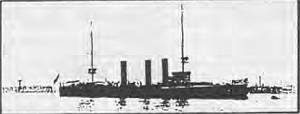- Author
- Jarrett, Hugh
- Subjects
- WWI operations, RAN operations
- Tags
-
- RAN Ships
- HMAS Melbourne I, HMAS Sydney I, HMAS Australia I, HMAS Pioneer, HMAS Encounter I
- Publication
- July 1992 edition of the Naval Historical Review (all rights reserved)
On 9th August, the force arrived off Simpsonhafen and SYDNEY and the three destroyers were sent in at night to torpedo any ships found there. The great harbour was empty! Next day a search was made by the destroyers for signs of the W/T station without success.
As the force was becoming short of fuel ENCOUNTER and the destroyers were sent to Rossel Island, where MELBOURNE had arrived, to replenish. Meanwhile AUSTRALIA and SYDNEY carried out a sweep to the north of the Bougainville Island.
The New Zealand Samoan Expedition
Admiral Patey had been trying to contact C-in-C China Fleet without success on the 9th August and received an unexpected surprise in the form of a signal from New Zealand asking if it was safe for their Samoan expedition to start. This was the first he had heard of this enterprise, so he made his best speed to Port Moresby to make use of the cable facilities while his flagship coaled ship. In the meantime Admiral Jerram had destroyed the Yap W/T station and was on his way back to Hong Kong, where he arrived on 17th August.
On passage to Port Moresby, Patey developed plans for possible future operations. He had arrived at the conclusion that von Spee was well away to the north or north-east, probably making for America and, perhaps, calling at Samoa on the way. So he concluded it was well within his duties to make for Samoa.
It had been his intention to proceed with AUSTRALIA, SYDNEY and MELBOURNE to Nauru to destroy the German W/T station and had wirelessed his intentions to the Admiralty via Naval Board, Melbourne, on 13th August. This signal passed the one from New Zealand. He replied to New Zealand stating that it was not safe for the expedition to proceed without a strong escort. After considering it further, he came to the conclusion that an expedition to Samoa was a very desirable operation ‘if covered by the fleet’. He abandoned the Nauruan operation and decided to escort the New Zealand expedition with AUSTRALIA and MELBOURNE, leaving SYDNEY, ENCOUNTER and the three destroyers to cover the north approaches to Australia. The SYDNEY was to revisit Rabaul to continue the search for the W/T station.
Accordingly, Admiral Patey sent a signal to the Senior Naval Officer, New Zealand (SNONZ), which was received on 15th August, arranging a rendezvous 450 miles south of Suva on 24th August. Meanwhile AUSTRALIA steamed on towards Port Moresby, where she arrived on 16th August and where the Admiral was astonished to hear that the New Zealand expedition had sailed for Samoa on the previous day.
On 11th August the Admiralty had given SNONZ permission to start, and on 13th August had sent orders to Patey to ‘support the expedition’, which were not received due to the low power of the Australian W/T stations and indifferent operators. The expedition started without any reference to Rear-Admiral Patey.
Rear-Admiral Patey was, by this time, in a thankless situation. He had a modest, but effective, fleet, comprising one battle cruiser, one old cruiser, two light cruisers and three torpedo-boat-destroyers. According to Standing War Orders, his first consideration was to bring the enemy ships to battle, therefore he had concentrated his force and carried out an attack on Simpson Harbour, Rabaul. There being no enemy ships there, he had carried out an offensive sweep to the north of Bougainville Island and had searched the Louisiade Archipelago without result.

Accordingly, the two great armoured cruisers sailed on 9 September for Apia 1,300 miles away, leaving NURNBERG and supply ships at Christmas Islands.
They reached Samoa on 14 September and dashed into Apia Harbour ready for battle early in the morning to find nothing but a couple of sailing boats present.
Von Spee could not recapture the island as he could not spare the men or hold it against counter-attack. He could not bombard because it would damage German property and he could not wait around and fall prey to the Australian squadron, which was sailing in the opposite direction anyway.
The news of his appearance at Apia was the first definite information of his whereabouts that the Admiralty had received since 28 August.
One can only conjecture at the feelings of Admiral Patey when he realised how his appreciation of Von Spee’s probable movements had been so correct. He must have been quite dismayed at his lost chance at lasting glory at not being able to stay in the vicinity of Samoa and bring von Spee to battle.
Certainly, he served Australia and the Admiralty well, and there is very little doubt that, had we not had him and the fire-power of one battle-cruiser, the AUSTRALIA, to the north of our continent the SCHARNHORST and GNEISENAU-may well have caused great havoc off our coasts.




